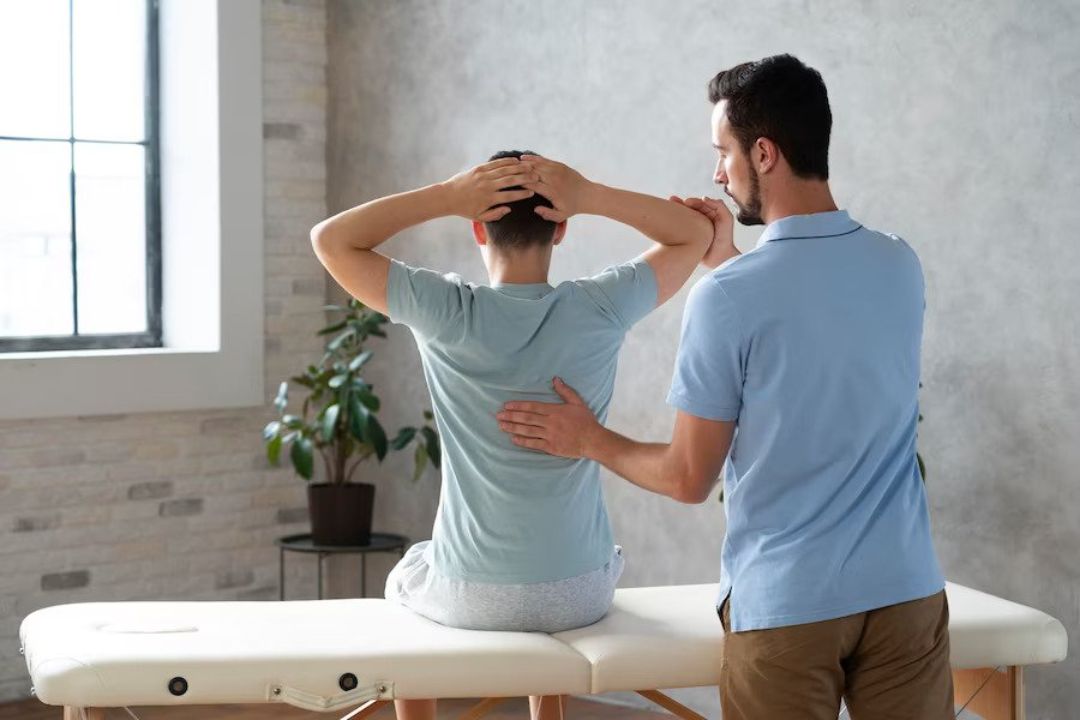Do you experience back pain that radiates to your arms and legs? If so, you may be suffering from a bulging disc.
A bulging disc is an abnormality in the spine that can cause significant discomfort. It’s important to understand the causes, symptoms, and treatment options for this condition in order to find relief.
Prepare to learn what a bulging disc is, how it’s diagnosed, the various treatments available, how to prevent further damage, and tips on managing the discomfort.
With careful medical attention and lifestyle adjustments you can get back to living a life free of pain.
A bulging disc is something that nobody wants to hear about, but it’s important to know what it is and how it can affect your health.
Also known as disc herniation, it occurs when the intervertebral disc expands and pushes against the vertebrae in the spine. This can cause pain and discomfort as well as limited mobility if not treated properly.
The most common causes are age-related degeneration, injury or trauma, repetitive stress on the back muscles or ligaments, or even genetics.

Photo Credit: Freepik
Treatment for a bulging disc usually involves nonsurgical treatments such as rest, physical therapy, stretching exercises, ice/cold therapy, and anti-inflammatory medications. In some cases, surgery might be recommended if other treatments do not work.
Prevention of a bulging disc includes maintaining good posture while sitting or standing for long periods of time, avoiding heavy lifting, getting regular exercise, eating a healthy diet with plenty of calcium and vitamin D, and managing stress levels effectively.
You may develop a herniated disc due to age-related spine degeneration, poor posture, and/or an injury. Bulging Disc is another term for Disc Protrusion, which occurs when the soft material inside a spinal disc pushes through a crack in its hard outer shell.
As you get older, your discs can break down due to Disc Degeneration, which can cause them to bulge outward or become weak. Poor posture, such as slouching, can also put extra pressure on your discs, creating tears that allow inner material to escape.
Accidents or heavy lifting can also cause trauma, leading to a bulging disc. Spinal Surgery may be required in some cases if the pain is severe and does not respond to conservative treatments like physical therapy or medications.
If you experience pain in your back or neck, it could be a symptom of a bulging disc. It is one of the common spinal disc problems that cause back pain and can lead to nerve compression resulting in radiculopathy.
The most common symptom of a bulging disc is localized pain in the affected area, accompanied by tingling sensations, muscle weakness, numbness, and difficulty controlling movement. This type of pain often increases with physical activity or certain movements such as bending over or coughing.

Photo Credit: Freepik
In some cases, symptoms may be absent until the person experiences an injury that triggers an increase in pressure on the affected discs. If this happens, the person may experience severe pain that radiates from their lower back to another part of their body along with other symptoms such as muscle spasms and reduced mobility. These symptoms can significantly disrupt daily activities.
Finding out what’s causing your back pain can be hard, but it’s worth getting a proper diagnosis.
A bulging disc is a common cause of lower back pain that requires specialized testing to confirm. An MRI scan or CT scan is often used to diagnose as they provide detailed images of spinal anatomy and can demonstrate areas where the disc has become displaced.
A Discography may be recommended if these scans don’t provide enough information. This involves injecting dye into the disc so that it can be seen more clearly on an X-ray and pinpointed exactly where the problem lies.
Knowing for sure what is causing your back pain allows you to find the best treatment plan and gives you peace of mind.
Tackling the pain of a bulging disc can be overwhelming, so it’s important to know that effective treatment options are available.
Corticosteroid injections may reduce inflammation and relieve pain from a bulging disc.
Another option is microdiscectomy surgery, which involves removing some disc material pressing on the nerves.
Chiropractic care and physical therapy may also help to improve mobility and strengthen muscles around the spine for better support.

Photo Credit: Freepik
Exercise specifically designed for a bulging disc can also help keep it under control by strengthening abdominal muscles and other muscles in the lower back.
Depending on your individual diagnosis, you may benefit from one or more of these treatments. Talk to your doctor about what’s best for you.
If nonsurgical treatments haven’t relieved your bulging disc, your doctor may suggest surgery. Surgery is often recommended for lumbar or cervical bulging discs. Depending on the location, severity, and cause, they may recommend a laminectomy or spinal fusion.
A laminectomy removes part of the bone that overlies the nerve root to make more room for it. Spinal fusion involves fusing two vertebrae together to reduce motion between them and create stability in the spine.
Your doctor will discuss with you the risks and benefits of each procedure so you can make an informed decision about which one is best for you.
Taking steps to prevent a bulging disc is essential in maintaining spinal health. Here are some important ways to reduce the risk of developing this condition:
Following these guidelines can significantly reduce the risk of developing a bulging disc and maintain a healthy spine.

Photo Credit: jcomp, Freepik
Coping with a bulging disc can be challenging, but you can take steps to manage your symptoms and reduce pain. Here are some tips to help:
Treatment for a bulging disc can range from conservative to surgical methods. Conservative treatments include pain medications, physical therapy, and lifestyle changes such as weight management and regular exercise. If these methods are ineffective, surgical options such as a microdiscectomy or spinal fusion may be considered.
In some cases, a bulging disc may heal on its own over time. The body can reabsorb the disc material that’s protruding, reducing inflammation and relieving symptoms. However, this process can take several weeks to months. It’s important to follow a doctor’s advice on managing symptoms and promoting healing during this time.
A disc bulge can be serious if it’s pressing on nearby nerves, causing pain, numbness, or weakness in the limbs. In severe cases, it can lead to conditions like sciatica or cauda equina syndrome, which require immediate medical attention. However, not all disc bulges cause symptoms or require treatment. It depends on the size and location of the bulge.
The main cause of bulging discs is age-related wear and tear, also known as disc degeneration. Over time, the discs in your spine can dry out and lose their flexibility, leading to bulging. Other factors that can contribute include improper lifting techniques, repetitive strenuous activities, obesity, and smoking.